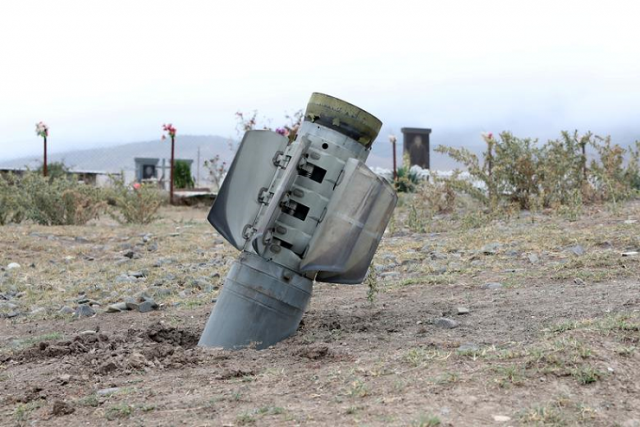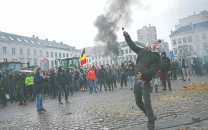Karabakh residents face lurking threat of unexploded cluster bombs
Both countries accuse the other of using the banned weapons in fierce clashes over the disputed province

A dozen clucking chickens dart around a small cylindrical object embedded deep in the dirt of their hillside coop, with the tell-tale fins of a cluster bomb emerging from the earth.
Throughout Stepanakert, the capital of the disputed Nagorno-Karabakh region in Azerbaijan, residents and activists are worried about the residual threat of unexploded cluster munitions near homes and along streets.
Both Armenia and Azerbaijan have accused the other of using the banned weapons in fierce clashes that erupted more than two weeks ago over the disputed province and persist despite a ceasefire agreed in Moscow last week.
The owner of the chickens discovered the small, 20 centimetre (8 inches) long munition in his backyard following a bout of Azerbaijani shelling that hit Stepanakert last week and called Arayik Arakelyan.
"They said: 'in my garden there is something... I don't know what is it'," Arakelyan, a member of the Halo Trust demining group, tells AFP as he shoos chickens away from the unexploded weapon sticking out of the ground.
As an employee of the international NGO working to clear landmines and other explosives that endanger civilians in conflict zones, the 43-year-old promised to come over and inspect the object.
It is just one of a slew of dangerous items that has spurred the organisation working in Karabakh to spread awareness over war debris.
Greg Polson, an explosive ordinance disposal (EOD) expert with HALO Trust, says the weapon is a 9N235 submunition, one of the 72 bomblets dispersed by a Soviet-made Smerch rocket.
The group is worried about the threat the lurking munitions pose to Stepanakert residents still in the city, after many fled or took shelter in underground cellars.
Since fighting broke out late last month, nearly 700 people have been killed including dozens of civilians. But the full death toll is believed be much higher because Azerbaijan has not revealed details of its military fatalities.
'A REAL RISK'
Karabakh officials claim their regional capital has been repeatedly hit by the Soviet-designed Smerch rockets in the clashes, while Azerbaijan has denied using the weapons.
The territory's rights ombudsman Artak Beglaryan in a report Wednesday denounced Azerbaijan's use of rockets armed with cluster munitions near civilian areas, particularly Stepanakert and the towns of Shusha and Hadrut.
Beglaryan wrote that Karabkh's emergency services had "found over 180 cluster munitions only in Stepanakert between September 27 and October 10".
Amnesty International last week said it corroborated the use of cluster bombs based on footage from Armenian sources.
Experts "were able to trace the location of the footage to residential areas of Stepanakert and identified Israeli-made M095 DPICM cluster munitions that appear to have been fired by Azerbaijani forces," Amnesty said in a statement.
Israel is a major arms supplier to Azerbaijan.
Amnesty said that "between 5 and 20 per cent of cluster bombs do not explode," posing a latent threat to civilians.
Polson says that "many look very attractive to children" and some weapons with pink strings attached in particular can be mistaken for toys.
"When they find it, they pull it, they swing it around and throw it away. That's a real risk," he adds.
So far 123 countries have joined an international convention adopted in Dublin in 2008 that bans the use of cluster weapons.
But Armenia and Azerbaijan are not among its signatories.
Cluster weapons' "use to attack civilian areas is particularly dangerous and will only lead to further deaths and injuries," says Denis Krivosheev, Amnesty's deputy director for Eastern Europe and Central Asia.
HALO Trust's Koen Van Der West warns the danger will remain even after the bombings have stopped.
"The main risk is going to be when people return to their houses, go to their gardens or to their balconies and then find these types of items," he says.



















COMMENTS
Comments are moderated and generally will be posted if they are on-topic and not abusive.
For more information, please see our Comments FAQ